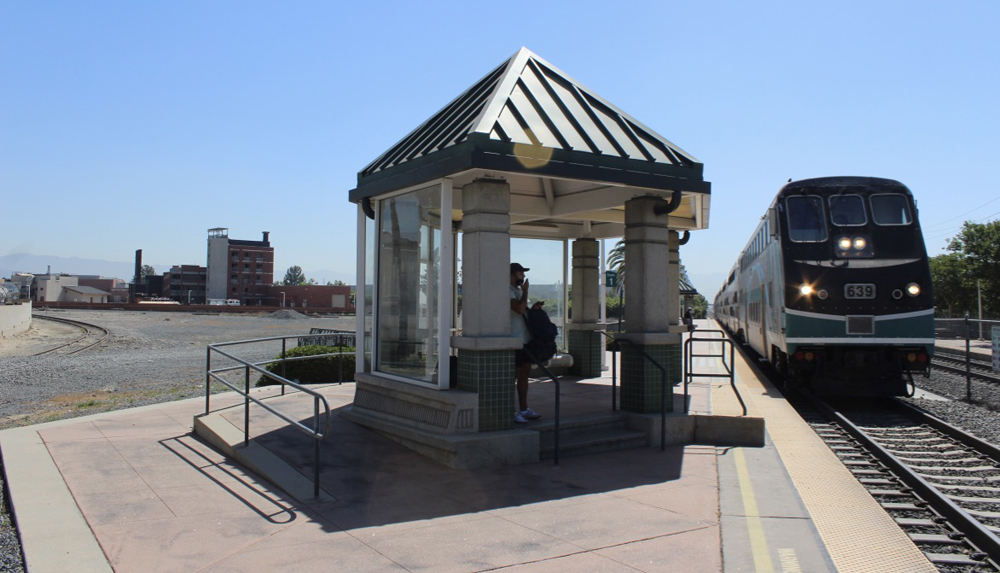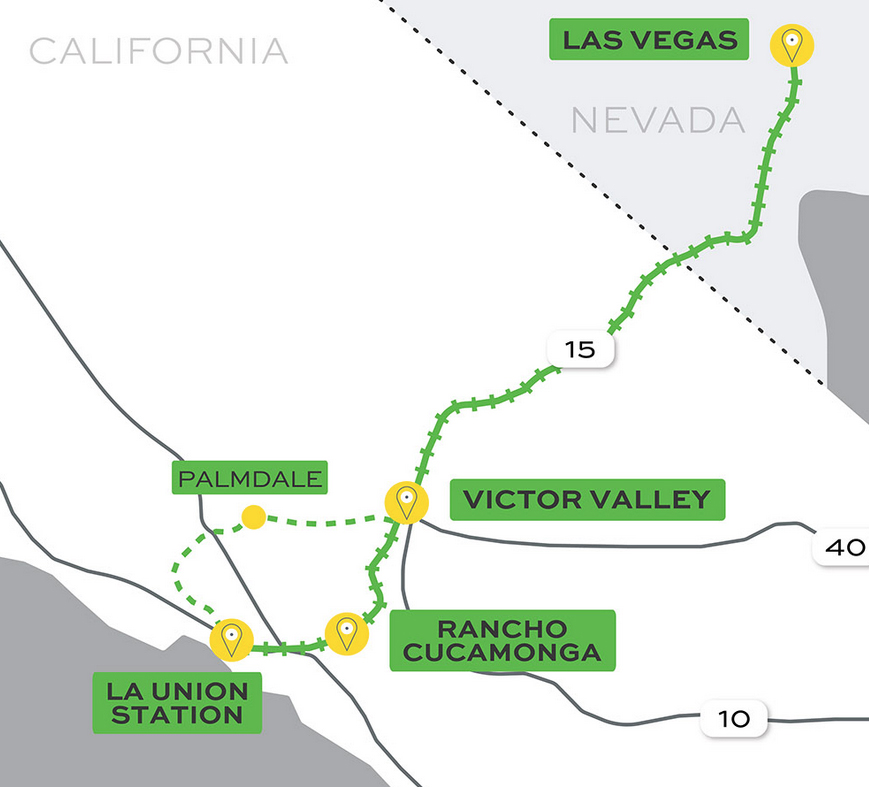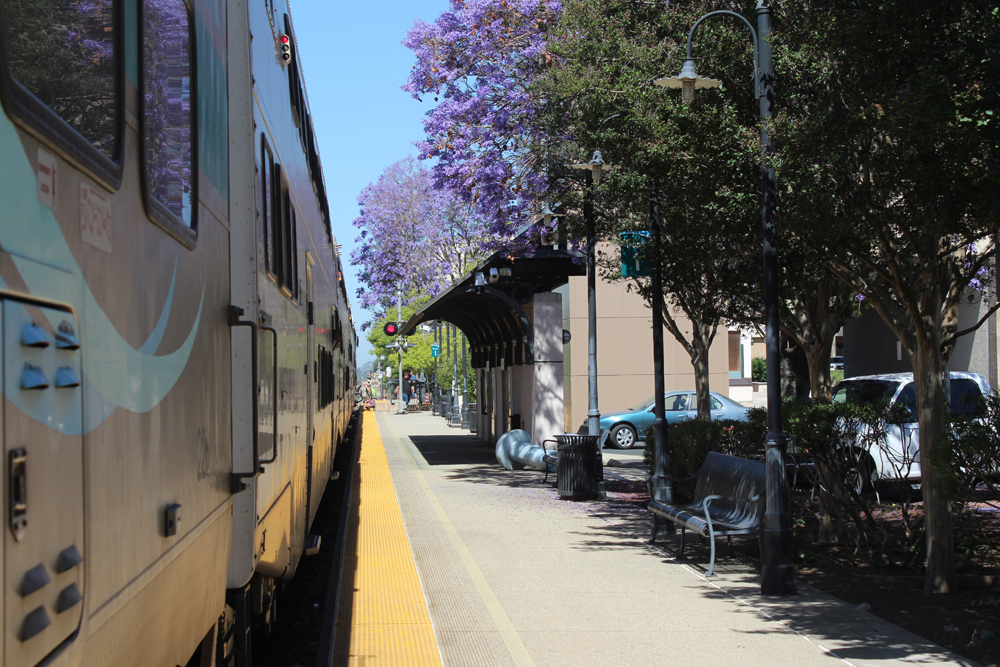
LAS VEGAS, Nev. — With environmental planning completed for construction of a 200-mph electrified railroad from Las Vegas, Nev., only as far as Victorville, Calif., Brightline West has entered into a memorandum of understanding with California transportation authorities to explore extending tracks to an existing Metrolink commuter rail station in Rancho Cucamonga, Calif., where passengers could transfer for trains to Los Angeles.
The agreement with the California Department of Transportation (Caltrans), the California State Transportation Agency, and the California High Speed Rail Authority, “sets the framework regarding the use of 48 miles within Interstate 15 to be used for Brightline West to connect its planned Victor Valley station and a newly planned station at Rancho Cucamonga,” according to a Brightline announcement.

It formalizes the company’s intention to bring trains closer to downtown Los Angeles on two routes: utilizing I-15 over Cajon Pass to Rancho Cucamonga and/or building a line to Palmdale, Calif., known as the “High Desert Corridor Alignment Project.”
Metrolink’s Antelope Valley Line also serves Palmdale, which has been designated as an interim destination for California High Speed Rail Authority’s route from San Francisco and the Central Valley until a separate entry into the Los Angeles Basin can be built. Brightline already has agreements to coordinate planning with both of those agencies and the San Bernardino Transit Authority.
The document tasks Brightline with preparing “an initial high-level feasibility study for the Cajon Pass Project” within 60 days, under the assumption that trains will run on 45-minute headways. It isn’t clear how much preliminary engineering has already been done on the I-15 route, which has far more challenging grades and curvature than the already-vetted 170-mile Las Vegas-Victor Valley segment.
At Rancho Cucamonga, a little more than 40 miles from downtown LA, the document says “a full-service transit station building will include the existing Metrolink platforms and a planned underground tunnel to Ontario International Airport.” This separate $85 million, 4-mile people mover loop proposed by Elon Musk’s Boring Company would use 12-passenger Tesla electric cars traveling at speeds up to 127 mph.
Metrolink travel time could be an issue
Brightline West’s station would provide a cross-platform rail connection to Metrolink’s San Bernardino Line. However, although the route cobbled together from former Santa Fe,

Southern Pacific, and Pacific Electric rights-of-way often allows 79-mph running, it possesses a number of single-track sections in the middle of or adjacent to freeways with little room for expansion. A pair of rush-hour expresses with three intermediate stops between Rancho Cucamonga and LA Union Station make the trip in about an hour, but other trains stop eight times and take 1 hour, 15 minutes.
Meanwhile, although some right-of-way preparation activities have begun on the Nevada portion of the route, financing issues have delayed construction the company originally said would start in 2021 [see “Brightline bond effort pushed back to 2022,” Trains News Wire, June 23, 2021].
The big question looming for this venture — as well as others including Brightline’s Florida expansion to Disney World, the California High Speed project, and Texas Central’s proposed 200-mph Dallas-Houston line — is whether Congress will finally pass infrastructure legislation that will permit greater use of private activity bonds and Railroad Rehabilitation and Improvement Financing loans.
Significantly, the memorandum also specifies that prior to construction on Caltrans rights-of-way, “Brightline West will demonstrate to the reasonable satisfaction of Caltrans that it has the financial ability to complete such portions of the Cajon Pass Project through equity or financing.”
The complete memorandum of understanding is available on the California State Transportation Agency site.














Sounds promising
Why spend millions to construct a transfer at Rancho. Just run Bright Line trains over Metro Link directly into LAUP. Less capital cost and much better and faster service. This really is a no brainer. They both use the same 56 1/2 inch gauge. With every thing else we have built, I would think we can find a way to add a second track in those single track segments. This is a project that will have to be addressed regardless at some point.
Bill McFonald
I would argue that Brightline West shouldn’t even go to Rancho Cucamonga and instead just build to Palmdale to connect with a potential Metrolink express service between there and LA, and when CAHSR tracks reach Palmdale then Brightline works with them to share construction costs of the Palmdale-LA segment in return for Brightline’s use of that route to provide direct LA-Las Vegas service. It would seem like a win-win for both, as Brightline can provide non-stop LA-Las Vegas service and CAHSR gets some much needed help completing a crucial part of its LA-SF route.
Jack Benny’s old show lives:
https://www.youtube.com/watch?v=NrTWjS9bT68
Will they be stopping at Anaheim and Azusa on the way to Cucamonga?
This nations population is aging out & birth rates are declining the Boomers lifestyles may not endure, change is inevitable.
Regarding the single track sections in the freeway, perhaps they should consider removing a lane to add a second track? Adding highway lanes only creates induced demand, meaning more cars on the road and subsequently more traffic. If Metrolink were improved then you’d expect more people to use it, and less to drive.
Taking a lane away from a highway in California (or any other metro area) would cause an up-roar like you’ve never seen. But if you swapped a lane with a new lane, if there’s room, that may be feasible.
At end of the day that is probably best way going forward. We need all the above approach to transportation in my opinion in a state full of 8, 10 and 12 lanes freeways. However, as always in America asking to removing auto lanes is a big ask. Even in California where we love our cars as much as everyone else
We tried that in the late ’70’s the first time Jerry Brown was Governor, on the Santa Monica Freeway. And it did not go over very well. Here is an article from the LA Times remembering the ordeal and its similarities to Covid. https://www.latimes.com/opinion/story/2021-09-20/1976-los-angeles-carpool-lane-anti-vax-protests Since then , CalTrans has always widened freeways to add HOV lanes!
I love brightline west.
I want brightline west.
What year is the brightline west going to be completed?
What makes you think it will be completed???
When is the brightline west going to be completed?